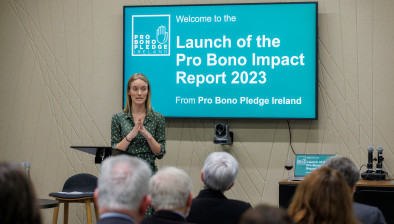Analysis: Green light for gender pay gap reporting this year

Ailbhe Dennehy
Matheson partner Ailbhe Dennehy and solicitor Ciara Taggart provide a timely update on the upcoming gender pay gap reporting obligations for Irish employers.
On International Women’s Day, the Minister for Children, Equality, Disability, Integration and Youth provided an eagerly awaited update on Ireland’s mandatory gender pay gap (GPG) reporting obligations.
In scope employers will be required to designate a specified “snapshot” date of their employees in June 2022 and then report the requisite pay and bonus information by December 2022. In short, employers will have a tight window (six months) to get their house in order and report the relevant data in time.
While the regulations to provide further detail on the form and manner of such reporting are outstanding, the Minister has committed to these regulations being published “in the coming weeks” and, in any event, before June 2022.
We have set out below an overview of the current legal position and what steps employers should be taking now to prepare.
What is the gender pay gap?
It is important from the outset to distinguish between the terms “gender pay gap” and “unequal pay”. These two concepts are often used interchangeably and such confusion can give rise to the impression that the existence of a GPG means that women in an organisation are not receiving like pay for like work – i.e. that there is some form of gender discrimination afoot.
The existence of a GPG within a business is not necessarily a red flag for discrimination. In fact, it is expected that an organisation (for a variety of internal and external factors) will have some degree of a GPG.
A GPG is the difference in the average gross hourly pay of women compared with men across a particular organisation. It is not seeking to identify unequal pay but rather to identify where women are represented across an organisation and the extent to which there is equal representation from both males and females at each level within an organisation. By dividing a business into quartiles (i.e. lower paid, lower-middle, upper-middle and upper paid) for calculation and reporting purposes, it is possible to identify where women are most represented across an organisation – whether in higher or lower earning roles.
What is the current legal position?
The enactment of the Gender Pay Gap Information Act 2021 in July 2021 provided a legislative basis for GPG reporting in Ireland for the first time. While the introduction of this legislation was welcomed following a number of false starts, the granular detail of precisely what information must be published and in what manner is pending. However, the government’s renewed commitment to requiring such reporting by the end of 2022, with a proposed “snapshot” date of June 2022, is a clear signal that the reporting obligations for in scope employers must be discharged this year.
Who is affected?
Employers with 250+ employees as of June 2022 will be required to publish their GPG data by December 2022.
This threshold will reduce to a headcount of 150+ employees within the first two years of the regulations and drop further to encompass all employers with 50+ employees within the first three years of the regulations. As the regulations are to be published imminently, it is expected that all employers with at least fifty employees will be in scope to report the relevant GPG data by 2025.
Notwithstanding the above eligibility requirement, in practice many employers who are outside scope are also taking steps to prepare to report their data to ensure they are in a position to remain competitive and recruit and retain key talent.
What information must be reported?
It is expected that the relevant regulations will put more shape and colour on the precise information that relevant employers will need to report this year. Employers will be required to report the difference in male and female remuneration expressly as:
- Mean and median hourly remuneration for full time and part time employees;
- Mean and median bonus;
- Percentage of all employees who have received a bonus or benefits in kind; and
- Proportions of male and female employees in the lower, lower-middle, upper-middle and upper quartile pay bands.
The Department of Children, Equality, Integration and Youth will publish guidance for employers on how the GPG calculations should be made. It is also noteworthy that plans are in place to develop an online reporting system for the 2023 reporting cycle, although it is unclear whether an online option will be available for the first round of reporting in December 2022.
Employers will also be required to publish a statement alongside the figures. This will require the employer to provide, in its opinion, the reasons for the differences in the mean and median pay and, significantly, the measures it has or intends to put in place to reduce or eliminate this gap. This requirement provides a critical chance for employers to contextualise the existence of the GPG and, significantly, set out their roadmap for shrinking the gap. As the duty to report is not a once-off exercise, but rather it is anticipated to be an annual requirement, the data reported and measures committed to will effectively serve as a yardstick against which an employer’s progress will be assessed year in, year out.
What preparatory steps should employers take now?
Turning to look at our neighbours in the UK, Irish employers have an invaluable opportunity to learn from their experiences and certainly one key learning was that collating and reporting the requisite data was not as easy as it might seem at the first glance. Employers are advised to take preparatory steps early to ensure an appropriate strategy around collating, computing, reporting and ultimately communicating, not just the output but also the steps to be taken to address any gap, is in place.
While we are awaiting the content of the regulations, there are a number of steps that can be taken now in anticipation of these requirements coming into effect, in particular given the short lead-in time for the first year of reporting (December 2022):
- Trial run. Consider a trial or dry run – identifying the relevant quartiles across your headcount and gathering and analysing payroll data.
- Technology. Look at how your business will actually crunch these numbers and produce the relevant statistical data to ensure accurate reporting. Do you have the right expertise in payroll or finance, do you have the right technology from a hardware or software perspective, is there a need to put in place appropriate training?
- Policies/procedures. Start looking at your existing policies and procedures when it comes to compensation structures and recruitment/promotion practices. Such a review might identify unintentional gender bias that may impact on the final figures.
- Stakeholders. Think about the line-up of your stakeholders – who needs to be part of your holistic approach to identifying and addressing the GPG? Certainly you will need to work with key personnel in payroll and finance, but equally you will need to work with your HR teams and external PR support when it comes to managing the message, both internally and externally.
- Legal advice. Involving your legal team early will also be vital – in particular when it comes to interpreting the content of the soon to be published regulations and understanding precisely what elements of “pay” need to be inputted in the calculations, addressing any discrimination claims that may arise and ensuring compliance to data protection principles.
In addition to the above preparatory steps, there are a number of other practical measures that employers can consider in order to seek to address any gap identified. These measures may form part of the explanatory statement accompanying the figures reported:
- Policies. The implementation of a comprehensive flexible/agile working policy working alongside a diversity and inclusion policy will be a core element in facilitating increased female representation in the labour market.
- Investment in Staff. Prudent businesses will explore ways to invest in staff talent through upskilling and reskilling with a focus on gender diversity – in particular diversifying the leadership pool and implementing innovative methods around talent development and integration.
- Training. The appointment of diversity managers and implementing culture reviews working hand in hand with unconscious bias training.
- Recruitment/promotion approach. Employers can also consider rethinking how they assess candidates for recruitment and promotion by using a transparent skill-based assessment based on clear and consistently applied criteria and structured interviews and even reviewing job descriptions to eliminate language that may be more likely to put off potential female applicants.
Conclusion
In reality, the real impact of this legislation is that it will force employers to highlight otherwise sensitive information that will impact directly on their brand reputation and profile as an employer, with a consequent impact on retention and recruitment. It essentially turns the labour market on the employer. This will be particularly effective in the highly competitive environment that employers are operating in now. One potential major defect in this approach, however, is that the disclosed gap may be misunderstood or, in some cases, driven by external factors beyond the employer’s control. The explanatory statement should go some way to putting their data in context, but may not always provide sufficient clarity.
Now that the government has given the outstanding regulations the “green light”, prudent employers are advised to take the above steps to prepare, in particular against the backdrop of the short lead-in time for the first year of reporting.

- Ailbhe Dennehy is a partner and Ciara Taggart is a solicitor in Matheson’s employment, pensions and benefits group.








